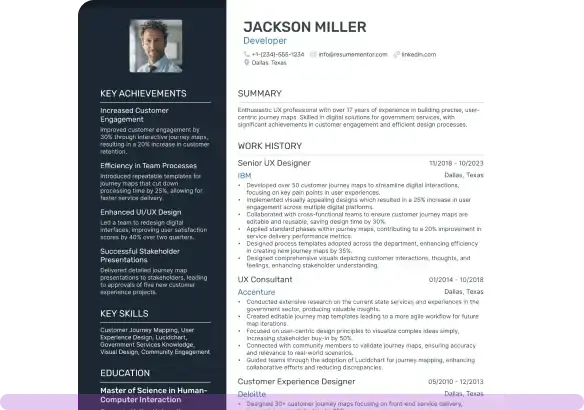System Administrator Resume Examples

Mar 26, 2025
|
12 min read
Unlock your system administrator resume potential with our expert guide. Craft a resume that communicates your troubleshooting prowess and attention to details, ensuring employers know you're the gateway to seamless network solutions.
Rated by 348 people
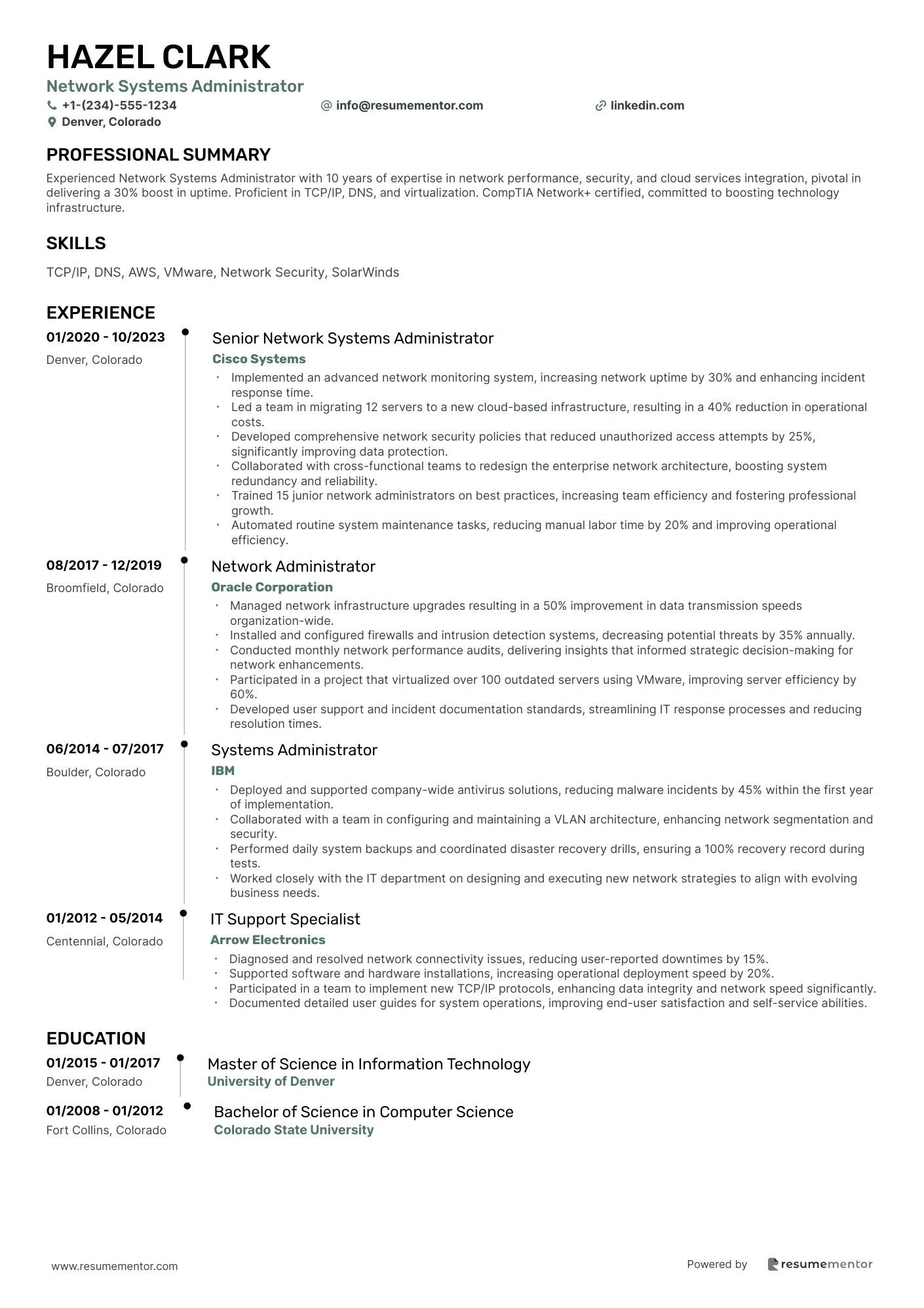
Network Systems Administrator
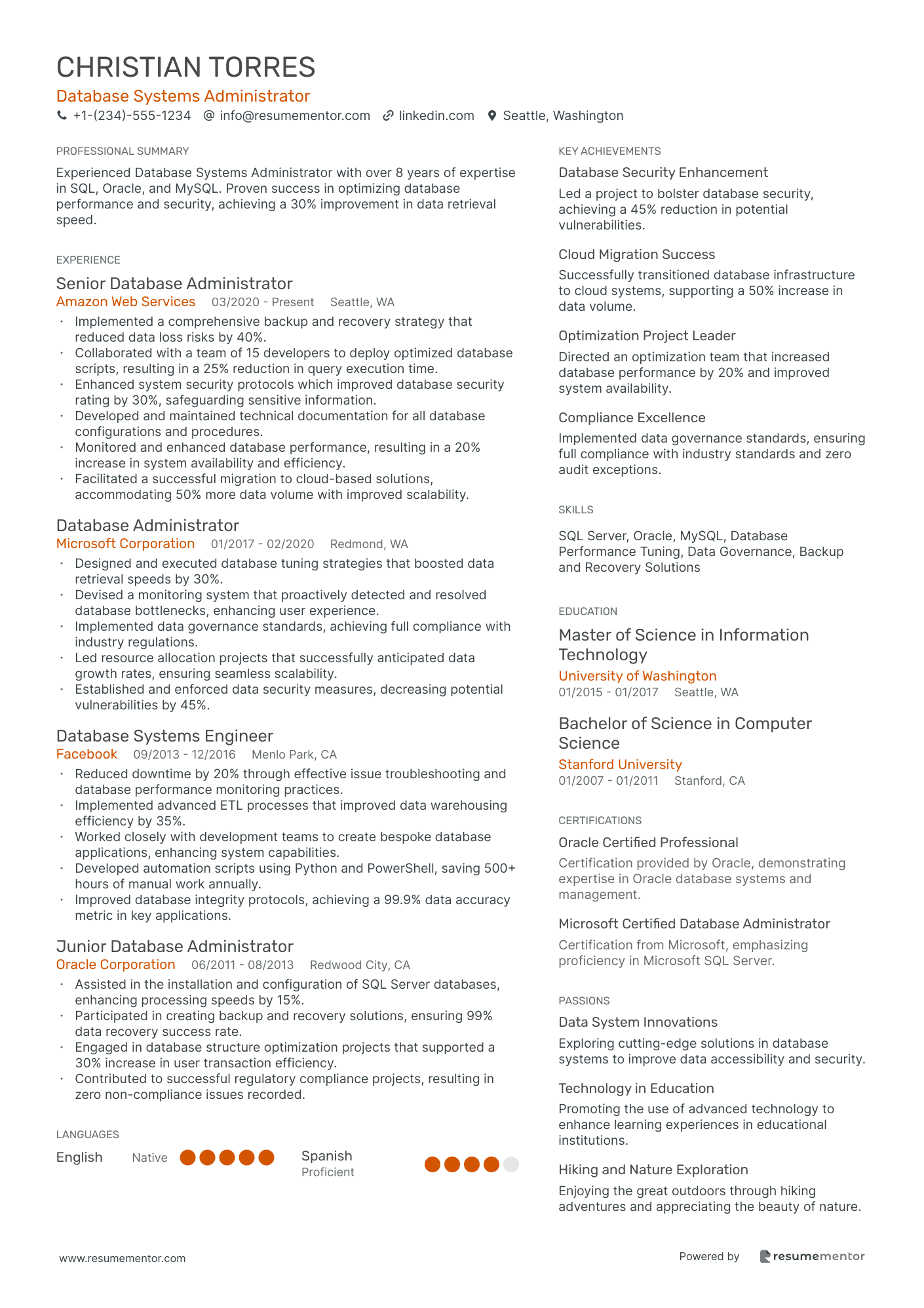
Database Systems Administrator
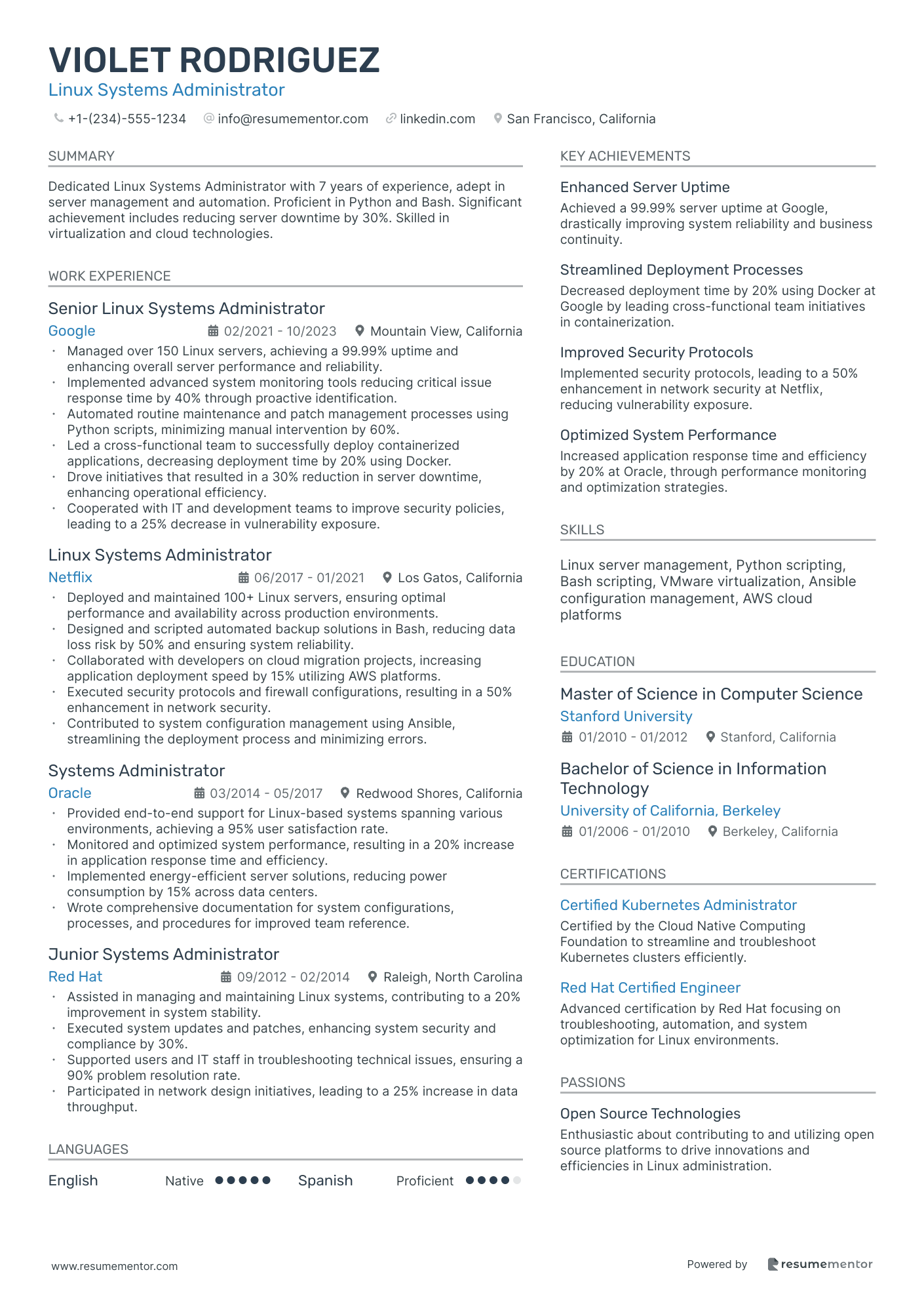
Linux Systems Administrator
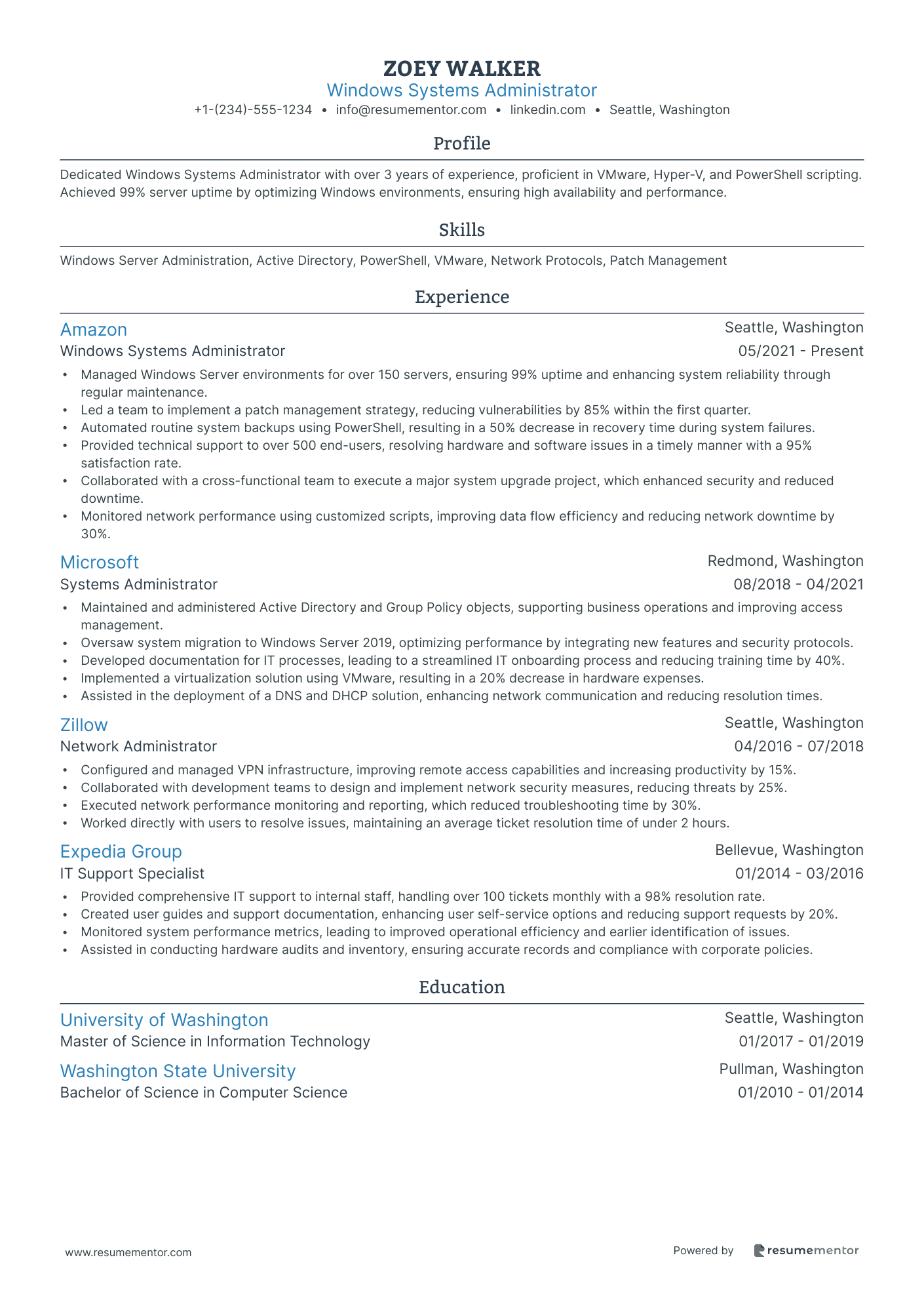
Windows Systems Administrator
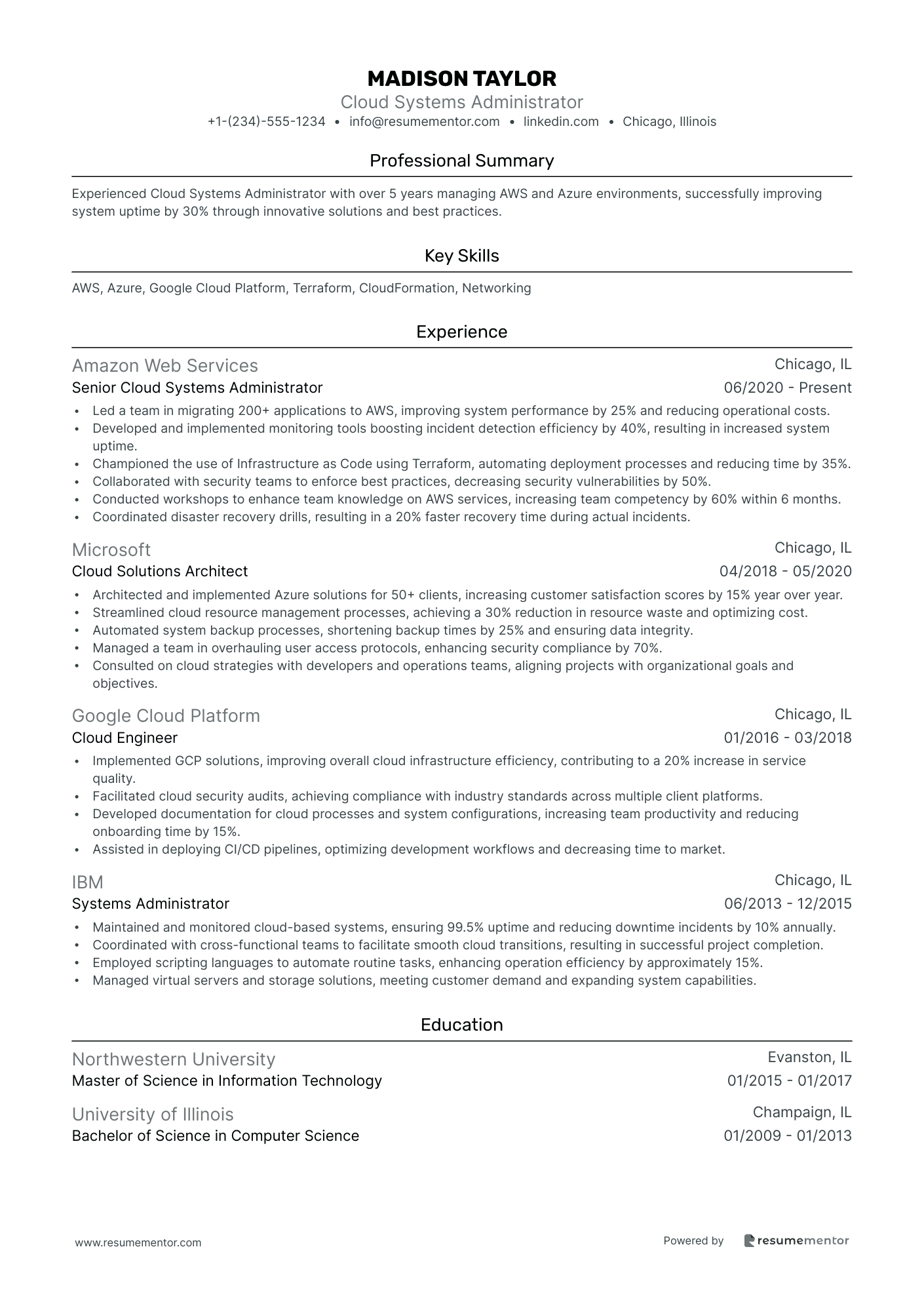
Cloud Systems Administrator
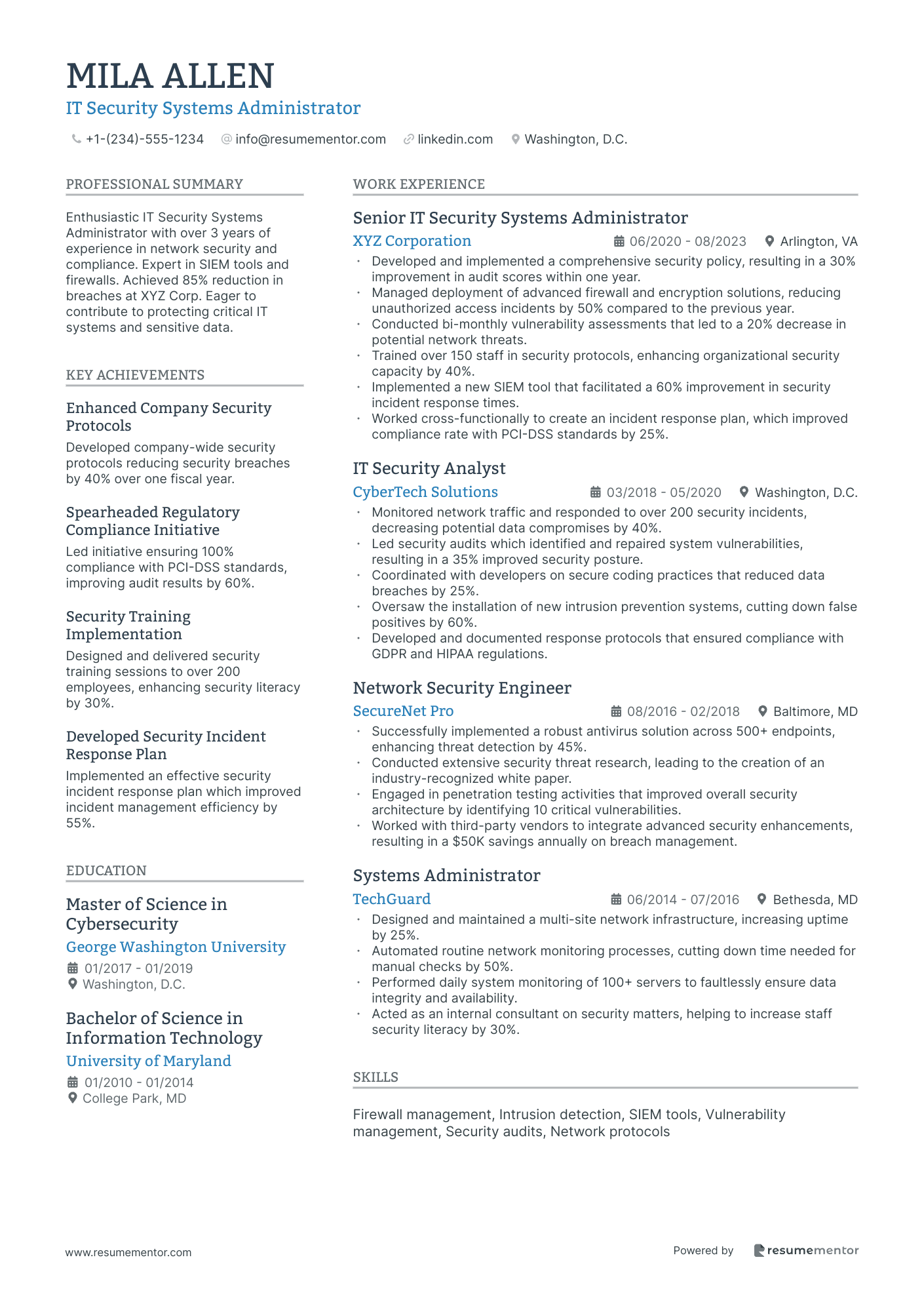
IT Security Systems Administrator
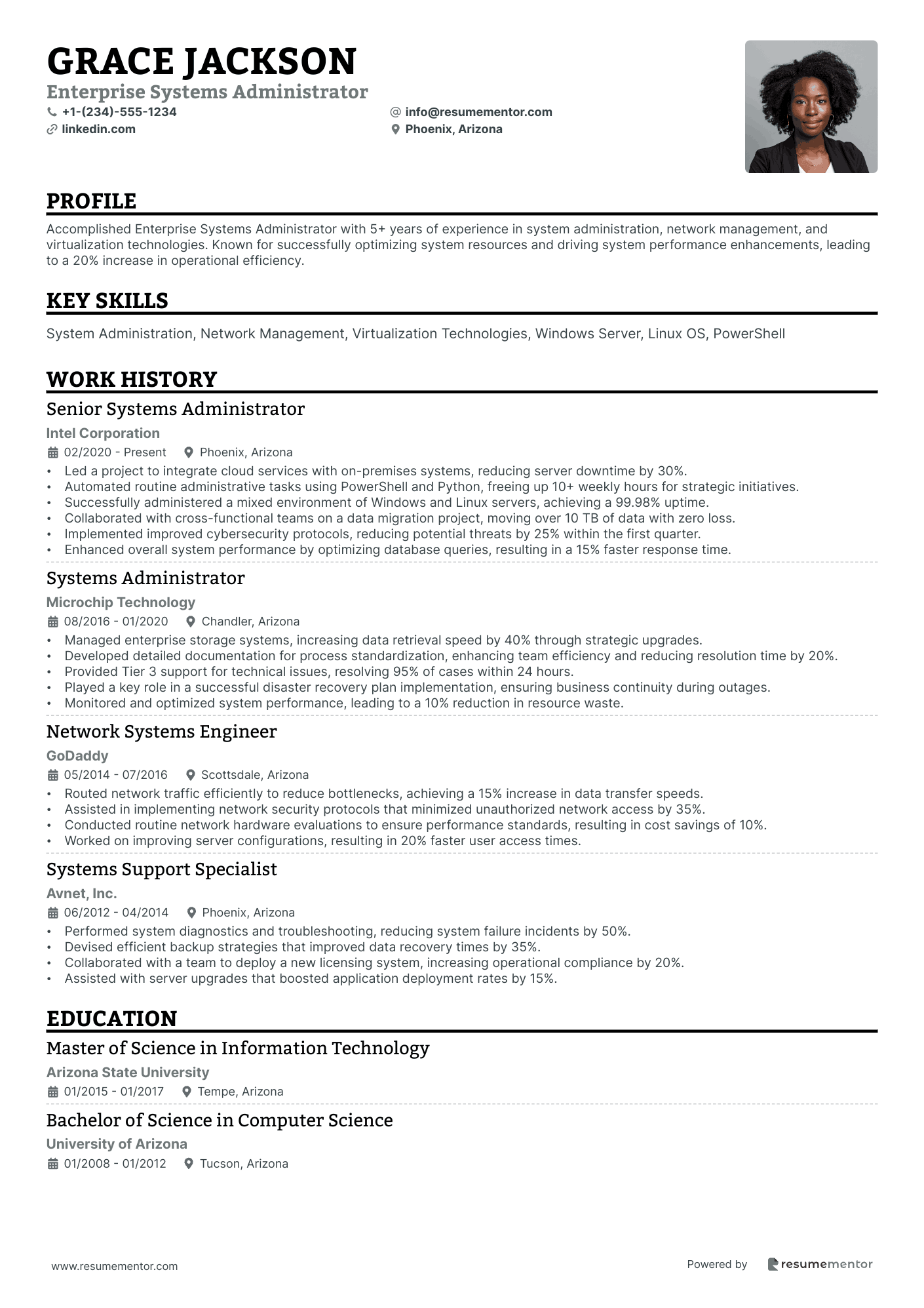
Enterprise Systems Administrator
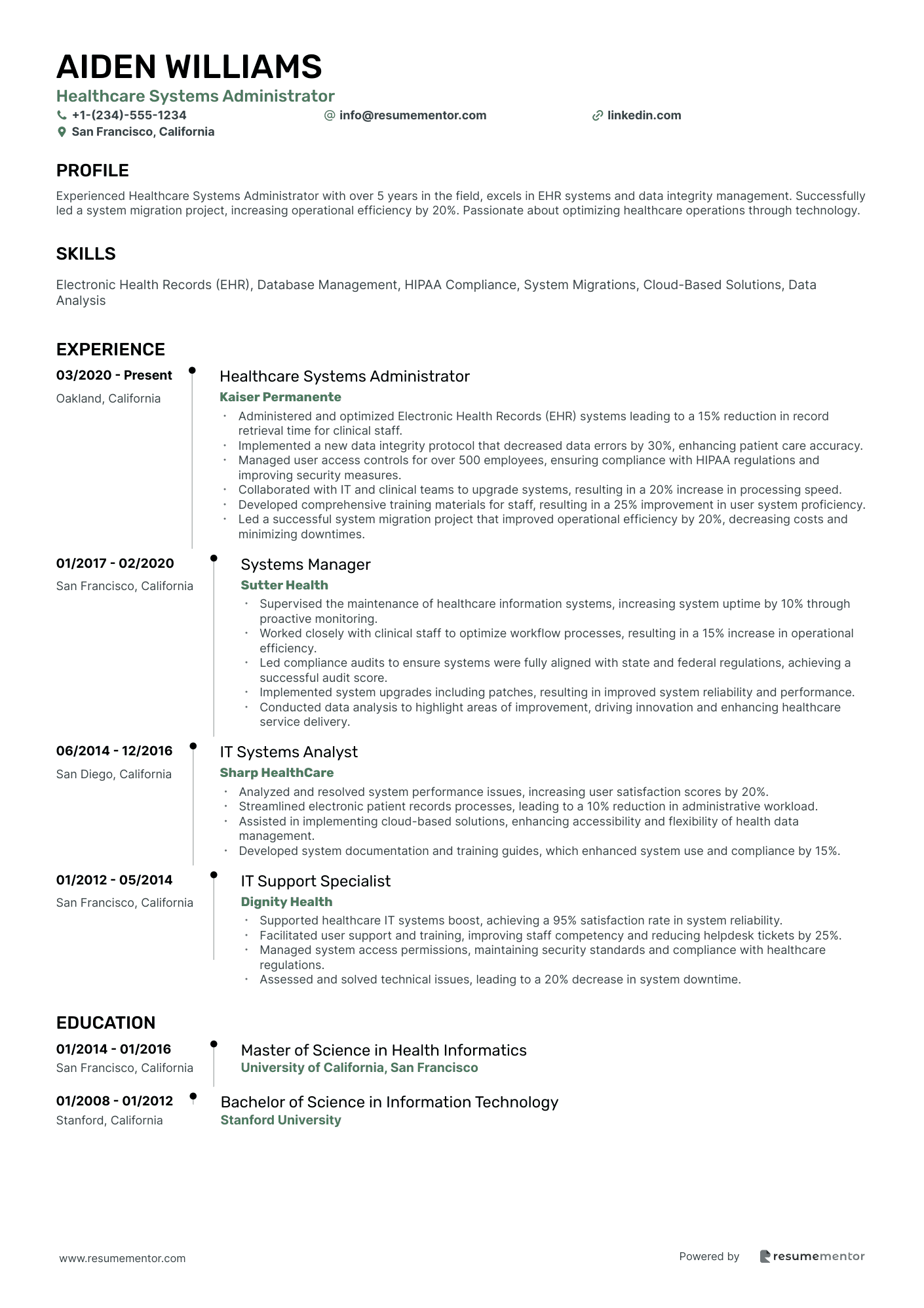
Healthcare Systems Administrator
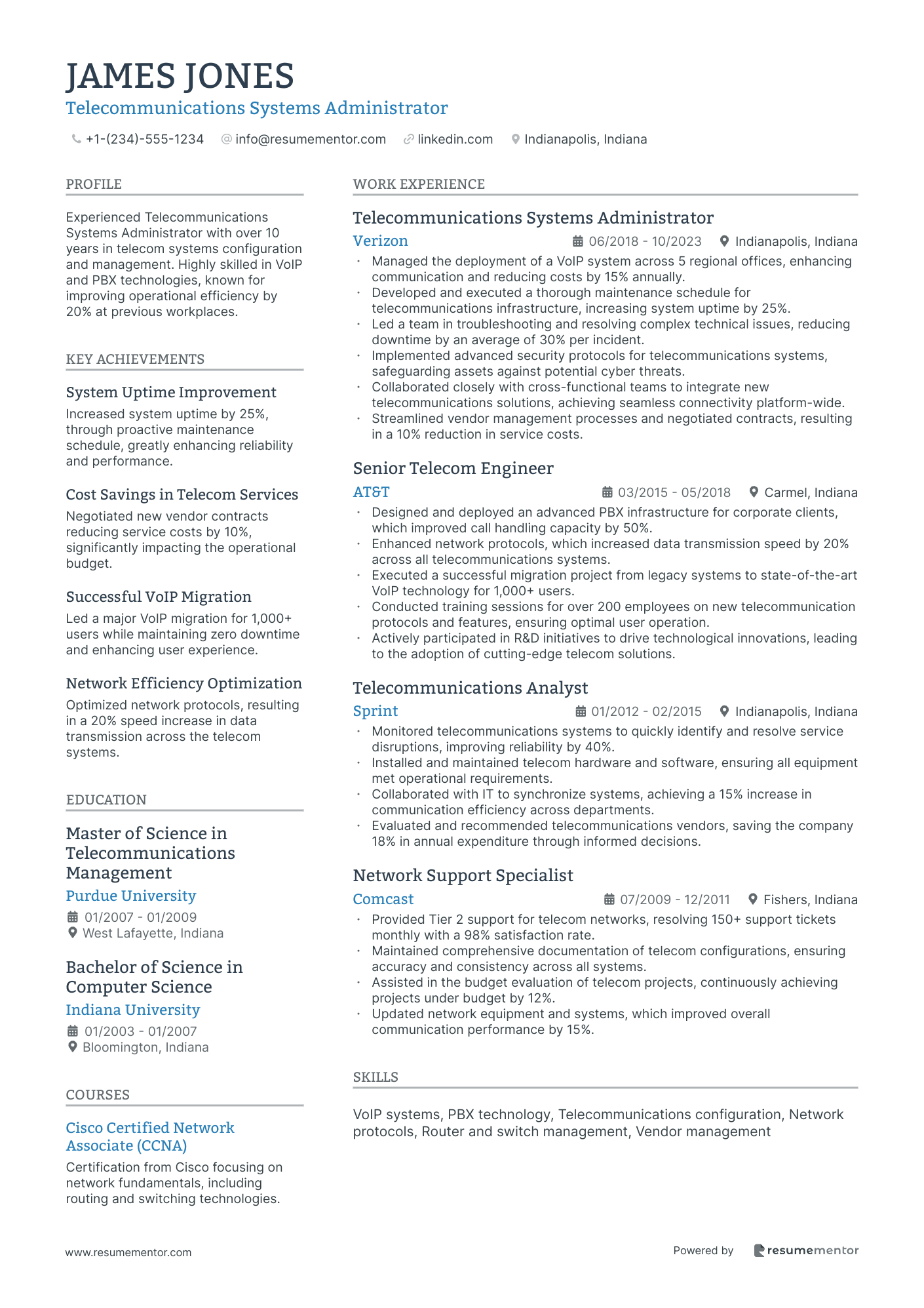
Telecommunications Systems Administrator

Junior Systems Administrator

Network Systems Administrator resume sample
- •Implemented an advanced network monitoring system, increasing network uptime by 30% and enhancing incident response time.
- •Led a team in migrating 12 servers to a new cloud-based infrastructure, resulting in a 40% reduction in operational costs.
- •Developed comprehensive network security policies that reduced unauthorized access attempts by 25%, significantly improving data protection.
- •Collaborated with cross-functional teams to redesign the enterprise network architecture, boosting system redundancy and reliability.
- •Trained 15 junior network administrators on best practices, increasing team efficiency and fostering professional growth.
- •Automated routine system maintenance tasks, reducing manual labor time by 20% and improving operational efficiency.
- •Managed network infrastructure upgrades resulting in a 50% improvement in data transmission speeds organization-wide.
- •Installed and configured firewalls and intrusion detection systems, decreasing potential threats by 35% annually.
- •Conducted monthly network performance audits, delivering insights that informed strategic decision-making for network enhancements.
- •Participated in a project that virtualized over 100 outdated servers using VMware, improving server efficiency by 60%.
- •Developed user support and incident documentation standards, streamlining IT response processes and reducing resolution times.
- •Deployed and supported company-wide antivirus solutions, reducing malware incidents by 45% within the first year of implementation.
- •Collaborated with a team in configuring and maintaining a VLAN architecture, enhancing network segmentation and security.
- •Performed daily system backups and coordinated disaster recovery drills, ensuring a 100% recovery record during tests.
- •Worked closely with the IT department on designing and executing new network strategies to align with evolving business needs.
- •Diagnosed and resolved network connectivity issues, reducing user-reported downtimes by 15%.
- •Supported software and hardware installations, increasing operational deployment speed by 20%.
- •Participated in a team to implement new TCP/IP protocols, enhancing data integrity and network speed significantly.
- •Documented detailed user guides for system operations, improving end-user satisfaction and self-service abilities.
Database Systems Administrator resume sample
- •Implemented a comprehensive backup and recovery strategy that reduced data loss risks by 40%.
- •Collaborated with a team of 15 developers to deploy optimized database scripts, resulting in a 25% reduction in query execution time.
- •Enhanced system security protocols which improved database security rating by 30%, safeguarding sensitive information.
- •Developed and maintained technical documentation for all database configurations and procedures.
- •Monitored and enhanced database performance, resulting in a 20% increase in system availability and efficiency.
- •Facilitated a successful migration to cloud-based solutions, accommodating 50% more data volume with improved scalability.
- •Designed and executed database tuning strategies that boosted data retrieval speeds by 30%.
- •Devised a monitoring system that proactively detected and resolved database bottlenecks, enhancing user experience.
- •Implemented data governance standards, achieving full compliance with industry regulations.
- •Led resource allocation projects that successfully anticipated data growth rates, ensuring seamless scalability.
- •Established and enforced data security measures, decreasing potential vulnerabilities by 45%.
- •Reduced downtime by 20% through effective issue troubleshooting and database performance monitoring practices.
- •Implemented advanced ETL processes that improved data warehousing efficiency by 35%.
- •Worked closely with development teams to create bespoke database applications, enhancing system capabilities.
- •Developed automation scripts using Python and PowerShell, saving 500+ hours of manual work annually.
- •Improved database integrity protocols, achieving a 99.9% data accuracy metric in key applications.
- •Assisted in the installation and configuration of SQL Server databases, enhancing processing speeds by 15%.
- •Participated in creating backup and recovery solutions, ensuring 99% data recovery success rate.
- •Engaged in database structure optimization projects that supported a 30% increase in user transaction efficiency.
- •Contributed to successful regulatory compliance projects, resulting in zero non-compliance issues recorded.
Linux Systems Administrator resume sample
- •Managed over 150 Linux servers, achieving a 99.99% uptime and enhancing overall server performance and reliability.
- •Implemented advanced system monitoring tools reducing critical issue response time by 40% through proactive identification.
- •Automated routine maintenance and patch management processes using Python scripts, minimizing manual intervention by 60%.
- •Led a cross-functional team to successfully deploy containerized applications, decreasing deployment time by 20% using Docker.
- •Drove initiatives that resulted in a 30% reduction in server downtime, enhancing operational efficiency.
- •Cooperated with IT and development teams to improve security policies, leading to a 25% decrease in vulnerability exposure.
- •Deployed and maintained 100+ Linux servers, ensuring optimal performance and availability across production environments.
- •Designed and scripted automated backup solutions in Bash, reducing data loss risk by 50% and ensuring system reliability.
- •Collaborated with developers on cloud migration projects, increasing application deployment speed by 15% utilizing AWS platforms.
- •Executed security protocols and firewall configurations, resulting in a 50% enhancement in network security.
- •Contributed to system configuration management using Ansible, streamlining the deployment process and minimizing errors.
- •Provided end-to-end support for Linux-based systems spanning various environments, achieving a 95% user satisfaction rate.
- •Monitored and optimized system performance, resulting in a 20% increase in application response time and efficiency.
- •Implemented energy-efficient server solutions, reducing power consumption by 15% across data centers.
- •Wrote comprehensive documentation for system configurations, processes, and procedures for improved team reference.
- •Assisted in managing and maintaining Linux systems, contributing to a 20% improvement in system stability.
- •Executed system updates and patches, enhancing system security and compliance by 30%.
- •Supported users and IT staff in troubleshooting technical issues, ensuring a 90% problem resolution rate.
- •Participated in network design initiatives, leading to a 25% increase in data throughput.
Windows Systems Administrator resume sample
- •Managed Windows Server environments for over 150 servers, ensuring 99% uptime and enhancing system reliability through regular maintenance.
- •Led a team to implement a patch management strategy, reducing vulnerabilities by 85% within the first quarter.
- •Automated routine system backups using PowerShell, resulting in a 50% decrease in recovery time during system failures.
- •Provided technical support to over 500 end-users, resolving hardware and software issues in a timely manner with a 95% satisfaction rate.
- •Collaborated with a cross-functional team to execute a major system upgrade project, which enhanced security and reduced downtime.
- •Monitored network performance using customized scripts, improving data flow efficiency and reducing network downtime by 30%.
- •Maintained and administered Active Directory and Group Policy objects, supporting business operations and improving access management.
- •Oversaw system migration to Windows Server 2019, optimizing performance by integrating new features and security protocols.
- •Developed documentation for IT processes, leading to a streamlined IT onboarding process and reducing training time by 40%.
- •Implemented a virtualization solution using VMware, resulting in a 20% decrease in hardware expenses.
- •Assisted in the deployment of a DNS and DHCP solution, enhancing network communication and reducing resolution times.
- •Configured and managed VPN infrastructure, improving remote access capabilities and increasing productivity by 15%.
- •Collaborated with development teams to design and implement network security measures, reducing threats by 25%.
- •Executed network performance monitoring and reporting, which reduced troubleshooting time by 30%.
- •Worked directly with users to resolve issues, maintaining an average ticket resolution time of under 2 hours.
- •Provided comprehensive IT support to internal staff, handling over 100 tickets monthly with a 98% resolution rate.
- •Created user guides and support documentation, enhancing user self-service options and reducing support requests by 20%.
- •Monitored system performance metrics, leading to improved operational efficiency and earlier identification of issues.
- •Assisted in conducting hardware audits and inventory, ensuring accurate records and compliance with corporate policies.
Cloud Systems Administrator resume sample
- •Led a team in migrating 200+ applications to AWS, improving system performance by 25% and reducing operational costs.
- •Developed and implemented monitoring tools boosting incident detection efficiency by 40%, resulting in increased system uptime.
- •Championed the use of Infrastructure as Code using Terraform, automating deployment processes and reducing time by 35%.
- •Collaborated with security teams to enforce best practices, decreasing security vulnerabilities by 50%.
- •Conducted workshops to enhance team knowledge on AWS services, increasing team competency by 60% within 6 months.
- •Coordinated disaster recovery drills, resulting in a 20% faster recovery time during actual incidents.
- •Architected and implemented Azure solutions for 50+ clients, increasing customer satisfaction scores by 15% year over year.
- •Streamlined cloud resource management processes, achieving a 30% reduction in resource waste and optimizing cost.
- •Automated system backup processes, shortening backup times by 25% and ensuring data integrity.
- •Managed a team in overhauling user access protocols, enhancing security compliance by 70%.
- •Consulted on cloud strategies with developers and operations teams, aligning projects with organizational goals and objectives.
- •Implemented GCP solutions, improving overall cloud infrastructure efficiency, contributing to a 20% increase in service quality.
- •Facilitated cloud security audits, achieving compliance with industry standards across multiple client platforms.
- •Developed documentation for cloud processes and system configurations, increasing team productivity and reducing onboarding time by 15%.
- •Assisted in deploying CI/CD pipelines, optimizing development workflows and decreasing time to market.
- •Maintained and monitored cloud-based systems, ensuring 99.5% uptime and reducing downtime incidents by 10% annually.
- •Coordinated with cross-functional teams to facilitate smooth cloud transitions, resulting in successful project completion.
- •Employed scripting languages to automate routine tasks, enhancing operation efficiency by approximately 15%.
- •Managed virtual servers and storage solutions, meeting customer demand and expanding system capabilities.
IT Security Systems Administrator resume sample
- •Developed and implemented a comprehensive security policy, resulting in a 30% improvement in audit scores within one year.
- •Managed deployment of advanced firewall and encryption solutions, reducing unauthorized access incidents by 50% compared to the previous year.
- •Conducted bi-monthly vulnerability assessments that led to a 20% decrease in potential network threats.
- •Trained over 150 staff in security protocols, enhancing organizational security capacity by 40%.
- •Implemented a new SIEM tool that facilitated a 60% improvement in security incident response times.
- •Worked cross-functionally to create an incident response plan, which improved compliance rate with PCI-DSS standards by 25%.
- •Monitored network traffic and responded to over 200 security incidents, decreasing potential data compromises by 40%.
- •Led security audits which identified and repaired system vulnerabilities, resulting in a 35% improved security posture.
- •Coordinated with developers on secure coding practices that reduced data breaches by 25%.
- •Oversaw the installation of new intrusion prevention systems, cutting down false positives by 60%.
- •Developed and documented response protocols that ensured compliance with GDPR and HIPAA regulations.
- •Successfully implemented a robust antivirus solution across 500+ endpoints, enhancing threat detection by 45%.
- •Conducted extensive security threat research, leading to the creation of an industry-recognized white paper.
- •Engaged in penetration testing activities that improved overall security architecture by identifying 10 critical vulnerabilities.
- •Worked with third-party vendors to integrate advanced security enhancements, resulting in a $50K savings annually on breach management.
- •Designed and maintained a multi-site network infrastructure, increasing uptime by 25%.
- •Automated routine network monitoring processes, cutting down time needed for manual checks by 50%.
- •Performed daily system monitoring of 100+ servers to faultlessly ensure data integrity and availability.
- •Acted as an internal consultant on security matters, helping to increase staff security literacy by 30%.
Enterprise Systems Administrator resume sample
- •Led a project to integrate cloud services with on-premises systems, reducing server downtime by 30%.
- •Automated routine administrative tasks using PowerShell and Python, freeing up 10+ weekly hours for strategic initiatives.
- •Successfully administered a mixed environment of Windows and Linux servers, achieving a 99.98% uptime.
- •Collaborated with cross-functional teams on a data migration project, moving over 10 TB of data with zero loss.
- •Implemented improved cybersecurity protocols, reducing potential threats by 25% within the first quarter.
- •Enhanced overall system performance by optimizing database queries, resulting in a 15% faster response time.
- •Managed enterprise storage systems, increasing data retrieval speed by 40% through strategic upgrades.
- •Developed detailed documentation for process standardization, enhancing team efficiency and reducing resolution time by 20%.
- •Provided Tier 3 support for technical issues, resolving 95% of cases within 24 hours.
- •Played a key role in a successful disaster recovery plan implementation, ensuring business continuity during outages.
- •Monitored and optimized system performance, leading to a 10% reduction in resource waste.
- •Routed network traffic efficiently to reduce bottlenecks, achieving a 15% increase in data transfer speeds.
- •Assisted in implementing network security protocols that minimized unauthorized network access by 35%.
- •Conducted routine network hardware evaluations to ensure performance standards, resulting in cost savings of 10%.
- •Worked on improving server configurations, resulting in 20% faster user access times.
- •Performed system diagnostics and troubleshooting, reducing system failure incidents by 50%.
- •Devised efficient backup strategies that improved data recovery times by 35%.
- •Collaborated with a team to deploy a new licensing system, increasing operational compliance by 20%.
- •Assisted with server upgrades that boosted application deployment rates by 15%.
Healthcare Systems Administrator resume sample
- •Administered and optimized Electronic Health Records (EHR) systems leading to a 15% reduction in record retrieval time for clinical staff.
- •Implemented a new data integrity protocol that decreased data errors by 30%, enhancing patient care accuracy.
- •Managed user access controls for over 500 employees, ensuring compliance with HIPAA regulations and improving security measures.
- •Collaborated with IT and clinical teams to upgrade systems, resulting in a 20% increase in processing speed.
- •Developed comprehensive training materials for staff, resulting in a 25% improvement in user system proficiency.
- •Led a successful system migration project that improved operational efficiency by 20%, decreasing costs and minimizing downtimes.
- •Supervised the maintenance of healthcare information systems, increasing system uptime by 10% through proactive monitoring.
- •Worked closely with clinical staff to optimize workflow processes, resulting in a 15% increase in operational efficiency.
- •Led compliance audits to ensure systems were fully aligned with state and federal regulations, achieving a successful audit score.
- •Implemented system upgrades including patches, resulting in improved system reliability and performance.
- •Conducted data analysis to highlight areas of improvement, driving innovation and enhancing healthcare service delivery.
- •Analyzed and resolved system performance issues, increasing user satisfaction scores by 20%.
- •Streamlined electronic patient records processes, leading to a 10% reduction in administrative workload.
- •Assisted in implementing cloud-based solutions, enhancing accessibility and flexibility of health data management.
- •Developed system documentation and training guides, which enhanced system use and compliance by 15%.
- •Supported healthcare IT systems boost, achieving a 95% satisfaction rate in system reliability.
- •Facilitated user support and training, improving staff competency and reducing helpdesk tickets by 25%.
- •Managed system access permissions, maintaining security standards and compliance with healthcare regulations.
- •Assessed and solved technical issues, leading to a 20% decrease in system downtime.
Telecommunications Systems Administrator resume sample
- •Managed the deployment of a VoIP system across 5 regional offices, enhancing communication and reducing costs by 15% annually.
- •Developed and executed a thorough maintenance schedule for telecommunications infrastructure, increasing system uptime by 25%.
- •Led a team in troubleshooting and resolving complex technical issues, reducing downtime by an average of 30% per incident.
- •Implemented advanced security protocols for telecommunications systems, safeguarding assets against potential cyber threats.
- •Collaborated closely with cross-functional teams to integrate new telecommunications solutions, achieving seamless connectivity platform-wide.
- •Streamlined vendor management processes and negotiated contracts, resulting in a 10% reduction in service costs.
- •Designed and deployed an advanced PBX infrastructure for corporate clients, which improved call handling capacity by 50%.
- •Enhanced network protocols, which increased data transmission speed by 20% across all telecommunications systems.
- •Executed a successful migration project from legacy systems to state-of-the-art VoIP technology for 1,000+ users.
- •Conducted training sessions for over 200 employees on new telecommunication protocols and features, ensuring optimal user operation.
- •Actively participated in R&D initiatives to drive technological innovations, leading to the adoption of cutting-edge telecom solutions.
- •Monitored telecommunications systems to quickly identify and resolve service disruptions, improving reliability by 40%.
- •Installed and maintained telecom hardware and software, ensuring all equipment met operational requirements.
- •Collaborated with IT to synchronize systems, achieving a 15% increase in communication efficiency across departments.
- •Evaluated and recommended telecommunications vendors, saving the company 18% in annual expenditure through informed decisions.
- •Provided Tier 2 support for telecom networks, resolving 150+ support tickets monthly with a 98% satisfaction rate.
- •Maintained comprehensive documentation of telecom configurations, ensuring accuracy and consistency across all systems.
- •Assisted in the budget evaluation of telecom projects, continuously achieving projects under budget by 12%.
- •Updated network equipment and systems, which improved overall communication performance by 15%.
Junior Systems Administrator resume sample
- •Improved network uptime by 25% through proactive monitoring and maintenance of servers and networked devices, reducing downtime significantly.
- •Collaborated with senior IT staff on a company-wide cloud migration project, resulting in enhanced data security and accessibility for over 300 users.
- •Streamlined backup and disaster recovery procedures, ensuring seamless data restoration and meeting a 99% success rate in data recovery tests.
- •Contributed to IT projects by deploying a new firewall system, enhancing overall network security and blocking 95% of malicious traffic.
- •Documented IT processes and procedures, creating user-friendly guides that improved system understanding and reduced troubleshooting time by 20%.
- •Utilized virtualization technologies like VMware to manage virtual servers, achieving a 15% increase in server efficiency.
- •Assisted in deploying and configuring network devices, enhancing overall network speed by 30% for all users.
- •Provided technical support to 200+ clients, ensuring prompt issue resolution, leading to a 95% satisfaction rate in customer feedback.
- •Trained entry-level IT staff in system monitoring tools and remote management applications, improving team efficiency by 20%.
- •Led a project to upgrade legacy systems to Windows 10, completing the project ahead of schedule and within budget requirements.
- •Played a key role in updating and maintaining company-wide IT security protocols, resulting in improved compliance with industry standards.
- •Managed daily operations of a 200-node network, maintaining high network availability and stability, resulting in a user satisfaction rate of 98%.
- •Implemented network monitoring protocols that led to a 40% reduction in network-related incidents over a six-month period.
- •Administered DNS server configurations and optimizations, enhancing website accessibility and load times for end users.
- •Configured firewall and security settings, safeguarding the network from external threats and improving cybersecurity defenses.
- •Resolved over 1500 technical support tickets, providing high-quality service and reducing resolution time by 30% on average.
- •Maintained and upgraded hardware and software systems, improving operational efficiency and reducing downtime by 15%.
- •Developed and maintained internal documentation for IT support procedures, improving clarity and ease-of-use for support staff.
- •Assisted in software rollouts across multiple departments, achieving deployment objectives effectively and enhancing productivity.
Navigating the job market as a system administrator can feel like managing a complex network, where every connection matters. Your deep IT expertise and troubleshooting skills keep systems running smoothly, yet translating those abilities onto paper presents its own set of challenges. To catch the eye of hiring managers, you need a strategy that highlights your strengths in a compelling way.
A well-structured resume acts as your strongest link to new job opportunities by effectively showcasing your skills. Presenting your experience clearly demonstrates your problem-solving capabilities and leadership in IT systems management. Using a proven resume template saves you time, ensuring that your document is professional and polished. A resume template allows you to focus on the content that best represents your abilities and achievements.
Creating a resume doesn't need to be overwhelming. It’s simply about showing how your technical skills can make an impact. From troubleshooting networks to managing server efficiencies, each detail should reinforce your value. Organizing this information logically ensures that you stand out in a crowded field.
Customizing your resume goes beyond listing past roles; it’s about aligning your expertise with the specific needs of employers. As you explore this guide, you'll uncover tips to make every section of your resume work to your advantage. With the right tools and approach, your resume can become a key asset in your job search.
Key Takeaways
- A well-structured resume is crucial for effectively showcasing your skills in IT systems management, helping you stand out in the job market.
- Customizing your resume to align your expertise with employer needs can make it a key asset in your job search.
- A reverse-chronological format is recommended for system administrator resumes to highlight career progression and technical skills.
- The experience section should emphasize achievements and use action verbs with real numbers for impact.
- Including extra sections like languages, hobbies, and volunteer work can provide a well-rounded view of your capabilities.
What to focus on when writing your system administrator resume
A system administrator resume should clearly communicate your technical skills and ability to solve problems, making it clear that you can manage computer systems effectively. Start by highlighting your expertise in networks, operating systems, and troubleshooting to grab the recruiter's attention.
How to structure your system administrator resume
- Contact Information: Make sure to list your full name, phone number, email address, and LinkedIn profile so they're easy to find and current. These details are your first impression, so keep them up to date. Presenting clear and accessible contact information ensures potential employers can easily reach you for interviews or further discussions—laying the foundation for the rest of your content.
- Professional Summary: Provide a brief overview of your experience and strengths that sets the stage for the rest of your resume. Mention skills like network management or server optimization that align with the job you're aiming for. Tailor this section to each application, emphasizing qualities and achievements that match the specific role—creating a seamless introduction to your capabilities.
- Technical Skills: This section is your chance to showcase key abilities such as network configuration, cloud management, and cybersecurity. Specify the software and hardware you excel in, reinforcing your professional summary. Use industry-specific terms that align with the job description to demonstrate your specialized knowledge, which naturally leads into detailing your work achievements.
- Work Experience: Here, detail your job history with a focus on achievements that demonstrate your capacity to maintain, optimize, and support systems effectively. Use action verbs to tie back to the impact you've had, illustrating your technical skills in action. This section should paint a picture of your career trajectory and preparedness for the role, seamlessly transitioning to your academic background.
- Education: This section should underline your academic background, listing your degree in computer science or a related field, the school name, and graduation date. Add relevant certifications like CompTIA Network+ or Microsoft Certified Solutions Expert to bolster your qualifications. Your educational background adds context to your professional experience and skill set, paving the way for detailing your key projects.
- Projects: Highlight important projects where you've solved complex issues or improved system efficiency, showing real-world applications of your skills. Detailing your role and successful results here ties back to your work experience and technical prowess. This final section demonstrates your ability to apply your skills in real scenarios, rounding out your qualifications before we explore each of these resume sections in more depth below.
Which resume format to choose
Your system administrator resume should effectively highlight your skills and experience, starting with a well-chosen format. A reverse-chronological format is particularly effective because it showcases the progression of your career and the depth of your technical skills. This format enables employers to quickly grasp your most recent roles and the relevance of your experience.
Selecting the right fonts enhances the readability and modernity of your resume. Opt for Raleway, Lato, and Montserrat—fonts that offer a clean, professional appearance without overshadowing your content. These fonts make your resume stand out while keeping the focus on your qualifications.
Saving your resume as a PDF is crucial for maintaining its integrity and layout across all devices. PDFs ensure your resume is viewed exactly as you intended, presenting a polished and consistent image to potential employers. This is particularly important for system administrators, where attention to detail is a critical skill.
Setting one-inch margins helps keep your resume organized and easy to read. These margins ensure that your text is not cramped, allowing for clear delineation between different sections of your resume. By maintaining a structured layout, your resume becomes much more inviting and accessible to hiring managers, which is essential in making a strong first impression in the competitive job market.
How to write a quantifiable resume experience section
Emphasizing achievements in your role as a system administrator, the experience section should spotlight your ability to drive results. Use a reverse chronological order to emphasize your most recent roles first, extending up to 15 years if the positions are relevant. Highlight roles that demonstrate expertise, tailoring each entry to closely align with the job ad's requirements. Opt for dynamic action verbs such as "implemented," "optimized," or "managed" to effectively convey your impact.
- •Reduced server downtime by 30% through enhanced monitoring and maintenance procedures.
- •Led a team of 5 in upgrading company-wide security protocols, decreasing security incidents by 40%.
- •Optimized network performance, improving data transfer speed by 25% without added costs.
- •Implemented automated backup solutions, doubling data recovery speed and improving reliability.
This experience section seamlessly connects your measurable accomplishments, clearly demonstrating the impact of your work. By using active verbs paired with real numbers, you paint a vivid picture of your contributions. Each achievement is organized to align with employers’ expectations for system administrators, focusing on optimizing performance and enhancing security. This tailored approach not only highlights your professional growth but also underscores your readiness to excel in future roles.
Collaboration-Focused resume experience section
A collaboration-focused system administrator resume experience section should emphasize your ability to work well with others in order to achieve shared goals. Begin by recalling situations where working together with your colleagues led to successful problem-solving or system improvements. Highlight these instances using action verbs and measurable outcomes, which demonstrate the tangible benefits of your teamwork. Remember that collaboration isn't just about human interaction; it also involves integrating systems, managing projects, and ensuring that information flows efficiently throughout the organization.
For example, if you played a part in rolling out new software, explain how you partnered with different departments to facilitate staff training and resolve issues. By sharing the results of your efforts—like increased efficiency or reduced downtime—you illustrate the impact of your collaboration. Emphasize how your teamwork contributed to the success of projects or helped the company smoothly navigate changes. Keep your descriptions concise, focusing on how your collaborative skills and contributions have positively influenced the workplace.
System Administrator
Tech Innovations Corp
January 2020 - Present
- Led a team to integrate a new CRM system, enhancing customer data accessibility by 30%.
- Worked closely with the support department to streamline processes, cutting ticket resolution time by 15%.
- Organized cross-departmental workshops to boost user training and the adoption of new software tools.
- Collaborated with IT security to implement robust data protection protocols, enhancing the security of sensitive business data.
Skills-Focused resume experience section
A skills-focused system administrator resume experience section should effectively highlight your technical expertise and achievements. Begin by selecting experiences that showcase your abilities in a clear, concise manner. Use quantifiable metrics to demonstrate the impact of your work, making it easier for the reader to see the value you bring. Incorporating active verbs and straightforward language will help convey your contributions, while each bullet point should emphasize a specific skill or accomplishment supported by concrete examples.
Structure this section by listing employment dates, your job title, and the workplace. If the company or industry is noteworthy, providing a brief description can add value. Your bullet points should focus on areas like network management, system optimization, and infrastructure enhancements, illustrating how your work has led to improved systems, enhanced user experiences, or increased efficiencies within the organization.
System Administrator
Tech Solutions Inc.
2018 - 2023
- Reduced server downtime by 30% with proactive monitoring and maintenance.
- Led a team of 5 technicians, improving ticket resolution times by 25%.
- Introduced an automated backup system, ensuring data safety and integrity.
- Enhanced network performance, increasing overall system speed by 20%.
Project-Focused resume experience section
A project-focused system administrator resume experience section should clearly convey your unique contributions and achievements in a cohesive manner. Start by detailing significant projects that showcase your skills and the impact you made. Clearly define your role in each project to demonstrate your achievements and how they benefited the company. Use simple language to describe the tasks you handled, highlighting their benefits and connecting them to larger project goals. Each bullet should emphasize your problem-solving skills, technical expertise, and ability to work collaboratively, seamlessly linking these aspects to demonstrate a comprehensive skill set.
Quantifiable outcomes are crucial for making your accomplishments stand out, as they provide tangible evidence of your impact. Mention the tools or technologies you used, weaving this information into the narrative to underscore your proficiency. This approach not only underscores your technical abilities but also illustrates how you manage complex challenges to drive successful outcomes. Ensure the experience section reflects your professional development and seamlessly connects your past experiences to the future role you’re aspiring to.
Senior System Administrator
Tech Solutions Inc.
January 2020 - Present
- Redesigned network infrastructure, boosting data transfer speed by 30% and reducing downtime by 20%, thus enhancing overall productivity.
- Implemented automated monitoring tools, significantly cutting response time to system alerts by 40% and ensuring system reliability.
- Collaborated closely with teams to standardize network protocols, which improved system compatibility and streamlined operations.
- Led and mentored a team of three junior administrators, fostering their professional growth and enhancing team performance.
Innovation-Focused resume experience section
An innovation-focused system administrator resume experience section should highlight your ability to think creatively and enhance systems effectively. Begin by showcasing projects where you introduced or improved systems, clearly explaining the impact on the organization. By emphasizing measurable outcomes, like increased efficiency or cost savings, you can illustrate the real value of your contributions.
Use strong action verbs in the bullet points to describe your actions and their positive effects, ensuring that each point flows seamlessly into the next. Highlight your teamwork skills by detailing collaborative efforts in developing innovative solutions, demonstrating your ability to work well with others. Including specific tools or technologies you mastered will further highlight your expertise and forward-thinking approach. Together, these elements create a cohesive narrative that shows how your innovative ideas lead to genuine benefits for your workplace.
System Administrator
Tech Innovations Inc.
March 2020 - May 2023
- Redesigned network architecture, increasing data availability by 35%
- Implemented an automated backup solution, reducing data recovery time by 50%
- Developed a customized monitoring system, proactively preventing 20% of potential outages
- Introduced a new IT asset management system, cutting inventory-related costs by 15%
Write your system administrator resume summary section
A summary-focused system administrator resume should immediately draw attention to your skills and accomplishments. Highlighting your most relevant experiences in just 3-5 sentences can make a powerful impression. Use action verbs to showcase your achievements and illustrate how your efforts have driven success. For instance:
This example provides a snapshot of your experience, skills, and real-world accomplishments, giving potential employers a quick yet comprehensive overview. Being specific and honest when describing yourself is key; avoid vague language that could undermine your credibility. Instead, use metrics or details to provide concrete examples of your capabilities. Knowing the difference between a resume summary and a resume objective will help tailor your application. While a summary highlights your skills aligned with the employer's needs, an objective is more about your career ambitions, which can be useful if you're changing fields. A resume profile offers a similar overview but goes into slightly more detail about your qualifications. On the other hand, a summary of qualifications lists your main skills and experiences in bullet points. Picking the right format depends on your career stage and the job you're aiming for.
Listing your system administrator skills on your resume
A skills-focused system administrator resume should effectively capture your technical abilities and strengths, both in a standalone section and integrated into other areas like your experience and summary. A dedicated skills section offers a quick snapshot of what you bring to the table, while weaving them into your professional experience shows how you've applied these in real-world situations. Think of your strengths, often referred to as soft skills, as your ability to communicate and solve problems—qualities that are just as important as technical prowess.
The hard skills you list are those technical competencies acquired through training and experience, such as expertise in a specific operating system or coding language. These skills, along with your strengths, can serve as keywords in your resume—essential for catching the attention of both recruiters and automated tracking systems. Using the right keywords ensures your resume aligns closely with job descriptions, enhancing your visibility in a competitive job market.
Here is an example of how a skills section can be formatted:
This section is effective as it lists key system administrator skills clearly and concisely, providing a broad overview of your capabilities. Each skill is relevant to the role and highlights critical areas of expertise necessary for success.
Best hard skills to feature on your system administrator resume
Hard skills for a system administrator demonstrate not only your technical expertise but also your ability to manage systems effectively. The goal is to convey your proficiency in handling IT infrastructure and resolving technical issues with efficiency.
Hard Skills
- Linux Administration
- Windows Server Management
- Network Configuration
- Virtualization Technologies
- Cloud Computing (AWS, Azure)
- System Security and Firewalls
- Database Management
- Backup and Recovery Solutions
- Automation and Scripting (Python, Bash)
- Active Directory Management
- Software Installation and Configuration
- System Monitoring and Performance Tuning
- Hardware Troubleshooting
- VPN and Remote Access Control
- Disaster Recovery Planning
Best soft skills to feature on your system administrator resume
Soft skills paint a picture of your interpersonal abilities and problem-solving prowess. As a system administrator, these skills communicate your capacity for collaboration, issue resolution, and stress management—key to thriving in demanding situations.
Soft Skills
- Communication
- Problem-solving
- Attention to Detail
- Time Management
- Adaptability
- Teamwork
- Patience
- Multitasking
- Critical Thinking
- Conflict Resolution
- Dependability
- Decision Making
- Initiative
- Emotional Intelligence
- Stress Management
How to include your education on your resume
The education section is an important part of your system administrator resume. This section showcases your academic background and should be tailored specifically to the job you are applying for. Including only relevant education means leaving out any degrees or courses not pertinent to the job. If your GPA is impressive, include it on your resume by specifying it in a 4.0 scale format, such as "GPA: 3.8/4.0". Achievements like graduating cum laude can be mentioned to demonstrate your academic excellence. When listing your degree, provide the degree name, institution, and dates attended, ensuring clarity and professionalism.
Avoid mistakes such as including unrelated education. Here's an example of a wrong education section:
Here's an example of what a good education section looks like:
The second example is effective because it highlights an IT-related degree, directly relevant to a system administrator role. The inclusion of a solid GPA reflects academic success, further enhancing your candidacy. Providing the degree details clearly and precisely helps potential employers assess your qualifications quickly.
How to include system administrator certificates on your resume
Including a certificates section in your resume is crucial for showcasing your qualifications as a system administrator. List the name of each certification clearly to ensure easy reading. Include the date you obtained the certification to provide a timeline of your professional development. Add the issuing organization to give credibility and context to each certificate. Certificates can also be subtly highlighted in the header area of your resume. For example, you can include "Certified AWS Solutions Architect" next to your name to immediately capture attention. An effective standalone certificates section on your resume could look like the following:
This example is effective because it includes relevant certifications in the field of system administration. Mentioning well-known organizations such as Microsoft and CompTIA adds reliability. The use of specific titles provides a clear snapshot of your expertise. Understanding how to compose this section strategically can make a significant difference in the impression you make on potential employers.
Extra sections to include on your system administrator resume
Creating a resume that stands out is key for any system administrator. Including diverse sections can showcase your skills, interests, and depth. As a system administrator, you handle complex tasks, but your resume should communicate your capabilities clearly and effectively.
Language section—Highlight any languages you know to show your global communication skills. Adding multiple languages can increase your job opportunities, especially in diverse companies.
Hobbies and interests section—Include this section to show what you like doing outside of work. Sharing relevant hobbies can demonstrate skills like problem-solving or attention to detail.
Volunteer work section—Mention your volunteer experiences to illustrate your commitment to community service. Providing specifics about your roles shows leadership and teamwork abilities.
Books section—Share books you've read to highlight your ongoing self-education. This section reveals your knowledge base and readiness to learn new technologies.
These sections help your resume give a fuller picture of who you are. A well-rounded resume can help you connect with potential employers on a personal level. Keep it simple and focused, and you will stand out in the hiring process.
In Conclusion
In conclusion, crafting an effective resume is crucial in standing out within the competitive job market for system administrators. Your resume serves as a reflection of your technical expertise, problem-solving abilities, and leadership skills. By structuring your resume carefully, you showcase not only your qualifications but also your readiness to contribute to the success of potential employers. Remember that a reverse-chronological format is highly effective in highlighting your career progression and skill development. Don't forget to integrate strong action verbs and quantifiable outcomes to vividly portray your achievements. Tailoring your resume to align with specific job descriptions can boost your visibility and appeal to recruiters.
Additionally, highlighting your education and certifications can lend credibility and show that you have the necessary foundation in IT. Including sections on languages, hobbies, or volunteer work further enriches your profile by presenting a well-rounded picture of who you are beyond your technical skills. When crafted thoughtfully, your resume becomes not just a list of qualifications, but a powerful tool in your job search arsenal. Remember, attention to detail and clarity can significantly enhance the impact of your resume, making it more memorable to hiring managers. Keep updating and refining it to reflect your evolving skills and experiences. By adhering to these guidelines, you'll ensure that your resume sets you on a path toward successful job opportunities in the bustling world of system administration.
Related Articles

Continue Reading
Check more recommended readings to get the job of your dreams.
Resume
Resources
Tools
© 2025. All rights reserved.
Made with love by people who care.

